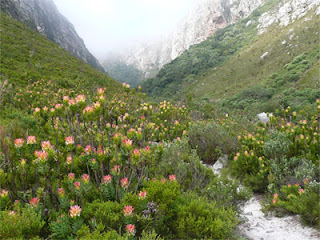For Bristol, this is extreme weather; usually we hardly go a week without rain, it’s been over a month. The plants in the Garden are taking it all in different ways; the aromatic Mediterranean plants look at home and are producing wonderful fragrant oils whose scents drift up as you brush past them. Tree ferns on the other hand need their trunks watered daily to stop them from drying out; native to wet forests they have adapted roots on their trunks to soak up all the rain.
 |
| The Fynbos of South Africa |
All plants need are sun, air, water and food and with these four essentials they can grow anywhere. Some of these places are more extreme than we ever experience here in the West Country, in South Africa for example. Plants of the Cape mountains are known as Fynbos, and many of these are dependant on fire for their survival. Fire clears the land and brings nutrients to dormant seeds that lay under shrubs and spurs some bulbs into flowering; just a few weeks after a bush fire regeneration begins. Similarly, in California the coastal redwood, Sequoia sempervirens, has fire retardant bark which protects and allows it to live through a thousand years of extremes.
 |
| Desert bloom. |
Extreme desert conditions are home to many species of plants from spiky armoured cacti to the amazing lithops or living stone. This plant camouflages itself by resembling a stone, preserving its water and becoming invisible to browsers. Also, desert annuals release their seeds which sit on the baking surface for a year until the small window of rain that arrives. The rain brings rapid growth, the plants putting all energy into producing flower and seed; this is known as a desert bloom.
Rainforests plants have large waxy leaves with adaptations for water runoff, such as ‘drip tips’ or
 |
Spongy fire retardant bark of the
coastal redwood |
holes through the leaves (see swiss cheese plant) to allow the heavy rain to drip down to the roots below. Other plants live on trees with roots hanging in the air to soak up water and leaf debris. Large trees produce buttress roots for extra stability as they are relatively shallow rooted, and each tree houses many other plants.
In the Arctic only a thin layer of soil above the permafrost exists which freezes and thaws through the season, so plants have a shallow root system and are able to photosynthesise in bitterly cold conditions; some can continue growing under a layer of snow. Many take advantages of the short polar summer and long days of sunlight by flowering and setting seed during this time. In all there are around 1,700 plants growing in the Arctic.
A Botanic Garden houses plants from all over the world which have adapted to the conditions of their own habitats, we do all we can to make them feel at home but sometimes the weather steps in. So whatever the weather throws at us, there is always a plant somewhere in the Garden that is very much at home.
Andy Winfield




